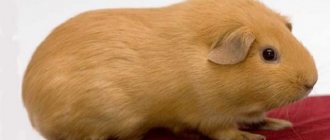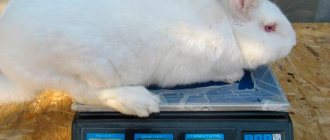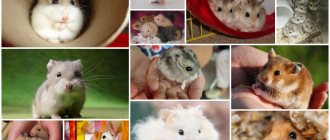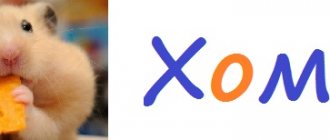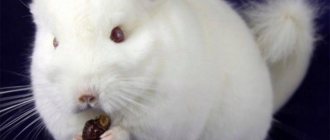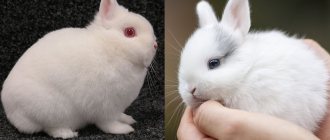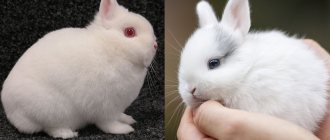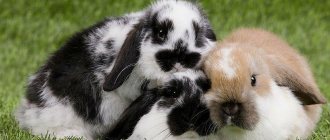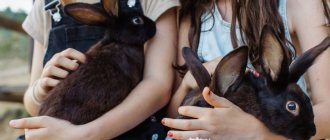Rabbits are bred all over the world, and these animals are raised not only for meat and skins, but also simply for beauty. There are about 60 breeds of rabbits in total, but in our country there are only 20.
This article will describe the main characteristics of the most productive breeds of rabbits that can be bred in household and agricultural farms.
Rabbit breeds with photos and names
A large number of rabbit breeds have no practical value, and only 15 of them, intended for slaughter for meat, as well as for the production of fur and fluff, have significant economic importance. They are divided into fur and downy ones, since there is no clear scientific classification of animals. Fur furs are divided according to their hair into short-haired and normal-haired, and according to the nature of the products obtained from them into meat-skin, skin and meat.
Breeds for home breeding
The following breeds are most often bred on homestead farms:
- White giant
Includes large-sized fur animals that are intended for the production of meat and skin products (Figure 1). The animals are strong and have the following external differences: an oblong body shape, a rounded croup, a deep chest, a light oblong head of medium size, wide and long ears, long widely spaced paws and a straight narrow back. Leptosomal type constitution.
Figure 1. White giant rabbits
Representatives of this species have pure white fur without any admixture of other shades, and for this reason their rearing would be appropriate for slaughter for their skins. The weight of animals can reach 5 kg, and the fertility of animals during calving can reach 8 cubs. It is the white giant breed that is considered one of the most common.
- Soviet chinchilla
This is a new highly productive species grown for meat and skin products (Fig. 2). Individuals have a strong body of the mesosomal type and tolerate various climatic conditions well. The animals have the following differences: the body is slender and wide, the head is small, and the middle ears are erect.
On the back, sides and rump there is a silver-gray-blue tone of hair, but on the rest of the body they are almost pure white with a light darkish underfur.
Figure 2. Soviet chinchilla
Soviet chinchillas are unpretentious and hardy to a variety of living conditions. The resulting skins are quite large, and the fur is thick and uniform. Animals are characterized by fast growth and high-quality meat. Females have good maternal qualities. With the right feeding ration, they can nurse up to eight young at a time.
- Vienna blue
This fur-bearing species includes medium-sized meat-and-skin animals. They have the following characteristic features: a slender, slightly elongated body, strong bones, a small head and medium-length ears. Body type – mesosomal. The hair is thick, soft, and has good shine.
Figure 3. Viennese blue rabbits
The color of the hair can be bluish-blue (ranging from dark to light shades), and the underfur and spine are colored proportionally (Fig. 3). Females are distinguished by a high level of fertility, as well as good maternal qualities, and successfully breed and feed up to eight cubs at a time. Males have high vitality and are perfectly adapted to various climatic conditions.
- Gray giant
The animals are quite large and belong to the representatives of normal-haired fur rabbits. They have a long, large body, a wide chest with a small dewlap, a large, rough-shaped head with long ears, and short limbs relative to the body. Representatives of the species belong to the leptosomal body type (Figure 4).
Figure 4. Gray giant rabbits
Meat quality is at an average level. Animals can have hare-gray, black, dark gray and ferruginous gray colors. If they are slaughtered as adults, they produce large skins. However, in terms of hair density, they are inferior to the skins of the white giant, Soviet chinchilla, black-brown and Vienna blue. Females are characterized by good milk production and high fertility (on average, about 8 rabbits are born per litter).
Representatives of the species are adapted to temperate and mild climatic regions of our country.
- Silver
Representatives of this fur breed are of average size and belong to the representatives of the meat-skin direction of productivity. Individuals are distinguished by a wide and compact body, which widens towards the rump. Representatives of this type have the following characteristic differences: a small head, a deep chest, straight and short ears, a wide rounded croup, muscular and strong legs (Figure 5).
Figure 5. Silver rabbits
The hair is thick and has an unusual shade of old silver. The guide hairs are black, the awn is white, and the underfur is slate blue. At the tip of the muzzle, ears, limbs and tail the fur is darker, but when the animal reaches the age of 4 months, the entire fur becomes silver, and in young animals a month old the hair is black. Females have good fertility (up to eight cubs per litter). Animals can be raised for slaughter, as they grow quickly and the meat has good dietary qualities.
- Californian and New Zealand White
These are fur breeds that were obtained through the selection work of American scientists. They have a strong body of the eirisomal type, the body is compactly grouped and has a cylindrical shape, a deep and wide chest, and thick legs.
Figure 6. Rabbits of the Californian (1 and 2) and New Zealand (3-4) breeds
Representatives of these breeds have thick and elastic white hair (Figure 6). However, California rabbits have a dark tint on the tip of their face, ears and tail. The young grow quickly, and the females have high milk production. They are recommended to be used for producing broiler rabbits for meat production, when kept with the mother for up to 74 days.
- Black-brown
This is a large breed that is raised not only for fur, but also for quality meat. The animals are very resistant to climatic conditions and have the following characteristic properties: an elongated body shape, strong bones, a rounded head with long ears, a wide chest, long strong paws, thick and lush hair.
Figure 7. Black-brown breed of rabbits
Upon reaching 4 months of age, rabbits have a black hair color, and adults have a shade of black-brown foxes (Figure 7). The resulting skins are not dyed before sale. The fertility of females per litter is eight rabbits.
- White down
This is a very resilient domestic species, which has the following features: thin and strong bones, a cylindrical body, a medium head and a wide chest, and muscular legs of medium length. White downy rabbits do not have tufts on their ears (a characteristic feature of Angora downy rabbits).
Figure 8. White downy rabbits
Representatives of the white downy breed are white in color (Figure 8), but sometimes black and blue shades of fur can be observed. In one litter, the female gives birth to up to seven cubs.
You will learn about what breeds of rabbits there are from the video review.
For the beginning farmer
In accordance with many years of experience in rabbit breeding in our country, it is considered rational and economically feasible to breed those breeds that are most common in the farmer’s area of residence.
This significantly simplifies the issue of repairing the herd, and novice rabbit breeders will have someone to learn from in keeping rabbits at the initial stage of farming.
- Choosing the best rabbit breeds is a responsible undertaking.
- Before making a decision, it is important to have a good understanding and be able to distinguish the individual characteristics of the breeds.
- Once the farmer has made his choice, he needs to wisely purchase the initial stock, since the health and productivity of the entire future herd depends on its quality.
- To be successful in rabbit breeding, the initial stock must have high genetic potential.
Therefore, it is not enough to make a choice based on a photo of a rabbit breed, but it is better to consult with more experienced farmers or breeders whom you trust.
Fur
Fur breeds include white and gray giant, Soviet chinchilla, silver, Vienna blue and black-brown. But since they were described above, let’s focus on other common fur breeds (Figure 9):
- The Veil Silver breed is most often bred for fur and meat production. As a result of crossing, animals with high fertility and milk production, high meat qualities, and with thick, shiny hair were obtained. The breed is adapted to being outside in cages in winter and summer. Main external characteristics include a long, dense body, a broad chest, a rounded large head with long ears, and strong, straight legs. The fur is thick and dark gray on the belly. The silver color appears after the first moult, and a thick black veil covers them seven to eight months after birth, that is, after the second moult. Animals are distinguished by high fertility, good meat qualities and average early maturity. However, the offspring often contains individuals with atypical fur color.
- Butterflies are white animals with dark spots located symmetrically on the sides and back. They were originally bred as decorative animals, so their weight did not exceed 3 kg. As a result of crossing, it was possible to improve their qualities. The main disadvantage: animals are prone to obesity. Obese females have low fertility, and fertilized and fledged females do not feed their offspring well.
- Soviet Marder are short-haired rabbits with valuable soft velvety fur. They occupy one of the first places in terms of the beauty of the skin. The body is proportional, the head is small and round. The color of the fur is heterogeneous in different animals and in each individual in different parts of the body (the muzzle, ears, tail and paws are much darker). Females have average fertility, and the resulting skins can be used without dyeing. However, uneven color creates difficulties when sewing fur products and reduces the quality of the skin.
Figure 9. Fur breeds: 1 - veil-silver, 2 - butterfly, 3 - Soviet Marder, 4 - Russian ermine.
Small species for fur purposes are represented by Russian ermine. These are hardy and unpretentious animals with a strong build, medium-sized head and erect ears. The color is white, and the ears, tail, paws and the end of the muzzle are black or brown. The weight of adults reaches 4 kg. Fertility is good (up to 8 individuals per litter), and the meat is valued for its tenderness. After slaughter, they obtain skins of different sizes that have no analogues in terms of fur quality. The main disadvantage is that when trying to increase body weight, the quality of the fur deteriorated.
Rabbit care basics
It is important for rabbits to have 24/7 access to clean water and food. Some breeds can chew constantly and put their face in the feeder up to 20 times a day. Large farms use automatic watering and cage cleaning systems.
All animals must be vaccinated, as rabbits are prone to infectious diseases. Nutrition should be balanced. Newborn rabbits should be kept with the uterus separately from all offspring.
It is important to constantly clean the cages so as not to breed germs and unpleasant odors, as this significantly affects the taste of the meat and the speed of development.
Meat
Breeding meat rabbits is the most profitable direction. The animals grow actively, gain weight well, have good muscles and produce tasty meat.
The best meat breeds are also called broiler breeds. These include New Zealand white, New Zealand red, Californian and Burgundy (Figure 10).
The highest quality meat is produced by New Zealand white and red animals. They have the following distinctive features:
- Medium in length, cylindrical body;
- Wide and fleshy abdomen;
- The head is wide with a slight curvature from the eye to the nose;
- Ears rounded at the ends, erect, short;
- The legs are straight, strong, the hind limbs are more fleshy;
- The eyes are pink (in albino individuals);
- Thick, shiny, soft fur;
- The breed is early maturing;
- The animals are hardy and prolific;
- Adults are calm and docile;
- They tolerate temperature changes well;
- Life expectancy is on average 5-10 years;
- The diet requires special attention.
The most unpretentious of all meat types is Californian . Such individuals do not have excess fat deposits, are quite fleshy, are distinguished by innate immunity and the ability to easily adapt. Their live weight is slightly less than that of the New Zealand ones, but they have superior growth rates and are distinguished by a strong build, thick white hair with dark spots on the muzzle, paws and tail. The animals are quite smart and friendly, and the live weight of adult individuals can reach 5 kg. Females are highly fertile, and the young quickly gain weight.
Figure 10. Representatives of meat types: 1 - New Zealand white, 2 - New Zealand red, 3 - Californian, 4 - Burgundy
The Burgundy is considered one of the best meat breeds. Its representatives reach sexual maturity already at 4 months of age. The body is muscular, covered with a skin of medium density light brown hair. Animal fur is not particularly valuable. Females are very fertile: a female can give birth to up to 12 cubs at a time. Animals grow quickly, have a strong body and good immunity.
The largest
The largest rabbits are classified as meat-skin rabbits. They do not grow too quickly, gain weight, and they require relatively a lot of food. These breeds are highly valued by farmers due to their good yield of meat products and skins of the highest and average quality.
It is easy for novice livestock breeders to work with these species, although the slaughter yield is incomparable with meat breeds, and the quality of fur is incomparable with any skin breeds. Meat-skinned animals are unpretentious, which means they get sick and die much less often than others, which is advantageous compared to demanding species.
Flanders or Belgian giant
With the help of Flanders, many meat and meat-skin breeds were bred. The individual is classified as universal. The absolute record holder for body size and weight - some individuals grow up to 12 kg, and on average an adult animal is 8-9. Such a rabbit has a very powerful, massive body, a relatively large head, and is monochromatic in color - black, creamy white, beige, sunny red. All cubs in a litter may be of different colors.
But this type has some disadvantages. Flanders grows for a long time, reaching adult weight in 8.5-9 months. Early slaughter does not make sense, because the mass is still too small. The animal is very capricious about its living conditions - it needs perfect cleanliness and a lot of space, food of the highest quality, otherwise the animals die.
Gray giant
Large rabbit of the meat-skin breed. It was developed in Ukraine in the middle of the last century. The animal is suitable for breeding by beginners; it adapts well to difficult conditions and does not require any special care. The female of this species weighs 4.5-5.5 kg, males - 6-6.5 kg, some individuals grow over 7.5.
The skin of the gray giant is of average quality, but very large in area, which is also valued by breeders. The meat score is slightly worse than other varieties. The animals reproduce very quickly and take excellent care of their young.
Soviet chinchilla
Outwardly, it is very similar to the gray giant in body size and fur color. It often grows larger, has more mass, and has a slaughter yield, so it is recommended for beginners. By 4 months, the average weight of the animal is 3.5-4 kg, it is already suitable for slaughter. The yield of this rabbit reaches 59%, which is considered a good indicator. The meat is tender, the skin and fur are also at their best.
The longer the animal lives, the greater the meat yield. This animal requires the freshest and highest quality food, otherwise the rabbits, especially the very young ones, will get sick and die.
White giant
The breed was developed by mating the Belgian with others, but only purebred albinos were used, which made it possible to obtain a perfectly snow-white variety with red eyes. All purebred representatives of giants do not have any admixtures of other colors - individuals are discarded and not allowed to reproduce.
The quality of the fur and skins is comparable to the Soviet chinchilla, the meat is also excellent, which allows livestock farmers to make a good profit from the sale of skins and carcasses.
The breed is not recommended for breeding by beginners, as it has various disadvantages. The White Giant's fertility is low, as is its early maturity, the quality of the meat is excellent, but the growth rate is low. It makes sense to slaughter an animal at least 7.5-8.5 months. Litters are rarely numerous, and the health of the cubs leaves much to be desired - this species is susceptible to a variety of diseases.
Breeds of domestic rabbits
Breeds of domestic rabbits include animals weighing no more than 2 kg. Their main types with photographs and names are as follows (Figure 11):
- The American fluffy sheep is relatively young. Adults of this breed have a live weight of 1.6 to 1.8 kg. Animals are smart and affectionate. A special feature is the increased level of fluffiness. Therefore, animals need careful coat care. The color can have about 20 options.
- Representatives of the British Polish breed have a significantly smaller size and body weight (about 1.1 kg) and are rightfully considered the smallest among their relatives. A feature is a temperamental disposition, so animals need specific upbringing. There are individuals of various colors, but white ones are the most common.
- American Polish dogs are sociable and enjoy participating in children’s games, which is why illusionists love to work with them. Weight is 1.6 kg, color – black, gray and chocolate.
- Dwarf Angoras are small, neat animals weighing up to 1.5 kg with fluffy fur. The animals have a calm, easy-going nature, get along well with other pets and people and do not require special care.
- The Dutch dwarf is one of the smallest. Its weight slightly exceeds 1 kg. The breed has become widespread, but the animals have a unique character. That is why it is not suitable for keeping in a house where there are children.
Figure 11. Domestic breeds: 1 - American fluffy ram, 2 - British Polish, 3 - American Polish, 4 - dwarf Angora, 5 - Dutch dwarf
What is the difference between a hare and a rabbit? Where do rabbits live in the wild?
An inexperienced person can easily confuse these animals, although they have a number of differences. You can distinguish the animals by their appearance. The hare is larger in size and its ears are longer. Hares change their color when molting twice a year, but for their brothers it remains unchanged. The structure of the limbs differs - hares have longer legs, since they have to run and jump a lot.
There are differences in the lifestyle of rodents. Hares are solitary creatures. They do not form herds and do not even live in pairs. They don’t dig burrows, they live in nests right on the ground, so their habitats are quite extensive. Rabbits are sedentary. They become attached to the holes they dig, improve them and expand them. There they breed and live as a large family.
The breeding season of hares begins in spring and ends in autumn. Rabbits do not take breaks and give birth all year round. A hare's pregnancy lasts two weeks longer. Rabbits are born completely helpless and need the care of their mother. Newborn rabbits are born covered with fur, see and hear well. The diet of adults is suitable for them.
An important difference is that hares could not be domesticated, despite all attempts. At every opportunity, they ran into the forest, preferring a less well-fed, but free life. Wild rabbits were made domesticated almost on the first try. A large number of rabbit breeds have appeared, which are bred in industrial farms, personal plots and even apartments.
A large number of wild rabbits live in Australia, where hares are not found at all. The largest population lives in North America. There are quite a lot of them in South America. They are also found in Africa, western and central Europe, Scandinavian countries, and the Pacific Islands.
Animals prefer to choose habitats with dense vegetation, along ravines with steep banks, in forests, meadows and clearings with tall grass and shrubs. Since they have to dig holes, light soils are preferred.
Downy breeds
The group of long-haired rabbits is commonly called downy rabbits. These include: Angora downy and white downy breeds (Figure 12).
Downy breeds are medium in size. So, the weight of Angoras is 3 kg, and that of white downy ones is 4 kg. The Angora downy dog is characterized by a short body with a large head and short ears, with fluffy tufts at the end of them. The coat is thick, silky, of various colors, represented mainly by long downy hair.
Figure 12. Angora downy and white downy breeds (from right to left)
The white down coat is characterized by an exclusively white color. The animals have a strong build, a round head with short ears, often without tassels, and muscular limbs.
Animal classification criteria
In addition to productivity, there are several directions for classifying animal populations. Depending on the size, the following types of rabbits are distinguished:
- large or giants weighing over 10 kg;
- medium, reaching a weight of 5–8 kg;
- small (hide and decorative species) weighing up to 5 kg;
- dwarfs whose weight does not exceed 2 kg.
According to the nature of the hair, individuals with medium-length hair, long-haired and short-haired (plush) are distinguished.
Among the various breeds, two groups can be roughly distinguished:
- amateur animals that are bred on private farmsteads for personal needs (butterfly, Soviet chinchilla, black-fired, Russian ermine, Angora, Flanders);
- industrial breeds bred on large farms (white pannon, Californian, New Zealand, rex).
Breeds of decorative rabbits - photos and names
Breeds of decorative rabbits are dwarf animals, similar to domestic ones. Their distinctive feature is large eyes and short ears. Among the decorative ones there are: lion-headed breed, dwarf rex, dwarf ram, dwarf fox and hermelin.
Figure 13. Ornamental species: 1 - lion-headed, 2 - dwarf rex, 3 - dwarf ram, 4 - dwarf fox, 5 - hermelin
Breeds of decorative rabbits with photographs and names are given below (Figure 13):
- A cross between short-haired and fluffy animals gave rise to the Lionhead breed. The animals got their name due to the resemblance of the head to a lion's mane. A thick mop of long hair covers the head and torso. The rest of the body is covered with short hair of various shades. The animals are small, their weight does not exceed 1.7 kg. They are easy to keep and care for.
- Short-haired individuals whose skin color is similar to that of a beaver belong to the Dwarf Rex breed. The features of dwarfism appear much more clearly due to the short hairline. They have underdeveloped, crooked whiskers, which is a sign of the purebred breed. The eyes are large, close to each other. Body length 50 cm, total weight – 1.4 kg. The color is different.
- Animals of the dwarf ram breed can be called giants among dwarfs, which does not prevent them from having a calm and docile character. The body is massive, 24-27 cm long and weighing 1.5 kg. The eyes are beautiful and big. The paws are of medium thickness, the small tail is pressed to the body. The skin is soft and silky. The color is varied. The peculiarity of this species is its hanging ears, similar to those of a lamb.
- But the dwarf fox is rightfully considered the midget among dwarfs, because the mass of animals of this breed is only 1.3 kg. The animals have a changeable character, and their body seems to be covered with a hanging woolen cloak. The coat color can be either light tones (white, silver) or more saturated (Havana, black, blue, yellow).
- Cute decorative white pets with blue eyes represent the Hermelin breed. Their weight is within 1.5 kg, and in their appearance they resemble Persian cats. Hermelines are stocky, tightly knit, with small, rounded, closely spaced ears, and the neck is invisible. The front legs are short, the claws are colorless. The coat is thick and shiny. The animal does not require special attention during maintenance and care.
You will learn more details about the popular species of these animals from the video.
The benefits of rabbit meat
In addition to valuable warm and hypoallergenic down, rabbits have valuable meat. This is not surprising, because it has many advantages:
- Rabbit meat contains little animal fat - cholesterol, which often becomes the main cause of disruption of intracellular metabolism and the development of atherosclerosis. This is a pathology of the vascular system, which occurs due to fatty deposits localized in the vessel. Because of them, blood circulation is disrupted and many problems arise - lack of oxygen, increased blood pressure, disruption of the heart muscle, and so on.
- Rabbits do not absorb pesticides used on plants. That is, this is the only animal whose meat does not contain poisons if it eats a processed product.
- Due to the high content of useful substances, rabbit meat reduces the radioactive effect on humans. Thus, it is recommended to take rabbit meat during chemotherapy and during the post-rehabilitation period in order to slightly protect your body.
- Meat is rich in proteins, which are absorbed almost completely.
Based on the above, we can conclude that rabbit meat, in comparison with the meat of other animals, is dietary and very healthy. That is why it is often used to feed small children who cannot eat fatty pork or beef. Rabbit meat is also ideal for people with gastrointestinal problems, as it does not cause irritation to the mucous membranes, is easily digestible and is quickly digested.
With constant use of rabbit meat, you can significantly improve your appearance and health. Fats, carbohydrates, vitamins, antioxidants affect all aspects - improve the functioning of all organs, strengthen the cardiovascular system, help strengthen nails, hair, bones, and take part in the elimination of facial wrinkles.
Varieties of breeds - on video:
Hermelin
Origin story.
These animals were bred in the 19th century, but appeared in Russia only recently. The first Hermelins were brought to the Moscow exhibition of miniature rabbits in 1998.
The Hermelin is often confused with its close relative, the Polish rabbit. Hermelins are rarely seen in Russia, but they are very popular in England.
Characteristic.
- The weight of these rabbits is about 1 kg.
- The color, according to the standards, is only pure white.
- The eyes must be either red or blue.
- Hermelines are short-haired (length - about 2 mm). The length of the ears is up to 7 cm.
Care.
You can bathe your rabbit no more than once a year. During the shedding period, be sure to comb once or twice a week.
Since hermelins often suffer from obesity, it is very important to properly balance their diet and calculate portions by grams
Signs of old age
Breeders do not always know exactly the age of their wards, so it is necessary to know the main signs that determine the onset of old age:
- Condition of the coat. The hair becomes less fluffy, stops shining, and bald patches appear.
- Eye expression. Young rabbits' eyes sparkle, their pupils are constantly in motion, as the rabbit records the situation around itself. In aging rabbits, the eyes do not sparkle, and there is almost no interest in what is happening.
- Physiological features. In aging animals, the skin on the belly begins to sag. Some breeds lose sight and hearing early.
Bathing
Some experts say that proper care for a lop-eared rabbit involves bathing it constantly. At the same time, other experts note that such procedures do not need to be carried out, since the rabbit is able to independently keep its fur clean. The main thing is that his cage is also clean.
Important! If you decide to bathe your pet, you should use only warm water.
In order for an animal to live in comfort, it is necessary not only to ensure the cleanliness of its cage and tray, but also to periodically let it go for walks around the room. The rabbit should walk every day for 2-3 hours. When choosing a place for walking, you need to make sure that there are no things there that can injure the rabbit or that it can chew.
See also Burgundy rabbit: description, breed productivity and breeding
You also need to remember that this breed of rabbits is very sociable. They need constant attention. In this case, the animal will respond with affection and love to its owner.
